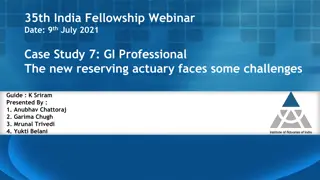Understanding the Actuarial Career and How to Become an Actuary
Actuaries play a crucial role in solving complex financial issues in various sectors such as insurance, banking, and government. This career path requires passing a series of exams focusing on probability, financial mathematics, and risk management. By mastering these concepts, individuals can work towards becoming renowned professionals in the field of actuarial science.
Download Presentation

Please find below an Image/Link to download the presentation.
The content on the website is provided AS IS for your information and personal use only. It may not be sold, licensed, or shared on other websites without obtaining consent from the author. Download presentation by click this link. If you encounter any issues during the download, it is possible that the publisher has removed the file from their server.
E N D
Presentation Transcript
THE ACTUARIAL CAREER Kelly McManus, FSA John Hancock Financial Services
What Is An Actuary? Actuaries are highly sought-after professionals who develop and communicate solutions for complex financial issues.
Where Do Actuaries Work? Insurance Other Life Insurance Banking Health Insurance Investments Property-Casualty Consulting Government
Life, Health, Annuities, General Insurance, Investments 9,849 Associates 5,729 Fellows Property and Casualty 2,206 Associates 4,709 Fellows
How to Become an Actuary Preliminary Exams Fundamentals of Actuarial Practice Modules Associate Professionalism Course 5 Exams 8 Modules 1 Interim Assessment 1 Final Assessment Half Day Course Fellowship Exams Fellowship Modules Fellowship Admission Course Core Exam (5 Hour) Advanced Exam (5 Hour) Risk Exam (2 Hour) Financial Economics Enterprise Risk Management Regulation and Taxation 3 Day Course
How to Become an Actuary Law of total probability, Bayes' theorem, discrete and continuous distributions, univariate and multivariate distributions, basic knowledge of insurance and risk management P Probability
How to Become an Actuary Law of total probability, Bayes' theorem, discrete and continuous distributions, univariate and multivariate distributions, basic knowledge of insurance and risk management P Probability Basic interest theory, annuities, bonds, loans, cash flows, portfolios, immunization, and financial derivatives, options, hedging, investment strategies, forwards, futures, and swaps Financial Mathematics FM
How to Become an Actuary Law of total probability, Bayes' theorem, discrete and continuous distributions, univariate and multivariate distributions, basic knowledge of insurance and risk management P Probability Basic interest theory, annuities, bonds, loans, cash flows, portfolios, immunization, and financial derivatives, options, hedging, investment strategies, forwards, futures, and swaps Financial Mathematics FM Models for Financial Economics Interest rate models, rational valuation of derivative securities, and risk management techniques MFE
How to Become an Actuary Law of total probability, Bayes' theorem, discrete and continuous distributions, univariate and multivariate distributions, basic knowledge of insurance and risk management P Probability Basic interest theory, annuities, bonds, loans, cash flows, portfolios, immunization, and financial derivatives, options, hedging, investment strategies, forwards, futures, and swaps Financial Mathematics FM Models for Financial Economics Interest rate models, rational valuation of derivative securities, and risk management techniques MFE Models for Life Contingencies Survival models, Markov chain models, life insurances and annuities, Traditional and Universal Life Models MLC
How to Become an Actuary Law of total probability, Bayes' theorem, discrete and continuous distributions, univariate and multivariate distributions, basic knowledge of insurance and risk management P Probability Basic interest theory, annuities, bonds, loans, cash flows, portfolios, immunization, and financial derivatives, options, hedging, investment strategies, forwards, futures, and swaps Financial Mathematics FM Preliminary Exams Models for Financial Economics Interest rate models, rational valuation of derivative securities, and risk management techniques MFE Models for Life Contingencies Survival models, Markov chain models, life insurances and annuities, Traditional and Universal Life Models MLC Construction and Evaluation of Actuarial Models Severity models, frequency models, aggregate models, construction of empirical models, construction and selection of parametric models, estimating failure time and loss, determining the acceptability of a fitted model, credibility, simulation C
A Day in the Life 8:00 AM: Wake up 8:30 AM: Commute to work 9:00 AM: Greet coworkers, catch up on people's evenings from the night before, and settle in to the workstation 9:10 AM: Go through emails and respond accordingly. Glance at the calendar to plan out the day. 10:00 AM: Campus recruitment committee meeting 11:00 AM: Catch up with interns on project, ask if they have questions on current project 11:30 AM: One on One meeting with manager 12:00 PM: Lunch with a group of coworkers
A Day in the Life 1:30 PM: Catch up on emails, send out agenda for my 3 p.m. meeting 2:00 PM: Get status updates from resources on their projects and tasks. Revise/update digital agenda accordingly. 3:00 PM: Meet with internal Audit 4:00 PM: Starbucks 5:30 PM: Gym 6:30 PM: Commute home 7:00 PM: Dinner
Quick Facts: Actuaries $100,610 per year $48.37 per hour 2016 Median Pay Typical Entry-Level Education Bachelor's degree On-the-job Training Long-term on-the-job training Number of Jobs, 2014 24,600 Job Outlook, 2014-24 18% (Much faster than average) Employment Change, 2014-24 4,400
Important Qualities Analytical Skills Communication Skills Math Skills Interpersonal Skills Computer Skills Problem- Solving Skills
Typical Student Programs Study Hours 2 Year rotations Exam raises Bonuses with credentials Seminars Exam Materials Celebrations
Insurance Product Pricing at John Hancock Premium Calculations (Excel) Financial Results (GGY Axis modeling) Balance profitability and competitiveness Analyze risk through sensitivities Communicate to senior management
Sample Problem An insurance company determines that N, the number of claims received in a week, is a random variable with P[N = n] =1/2n+1, where n > 0 . The company also determines that the number of claims received in a given week is independent of the number of claims received in any other week. Determine the probability that exactly seven claims will be received during a given two week period. (A)1/256 (B)1/128 (C)7/512 (D)1/64 (E)1/32
Solution: D Let N1and N2denote the number of claims during weeks one and two, respectively. Then since N1and N2are independent,
Questions Kelly McManus, FSA John Hancock Financial Services























